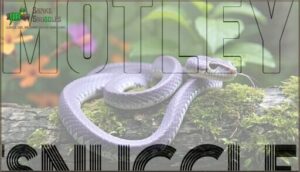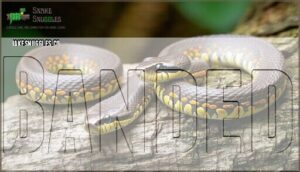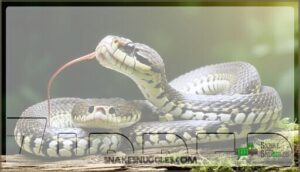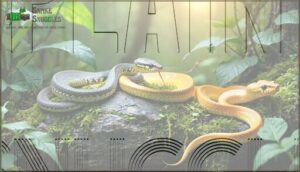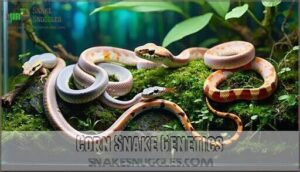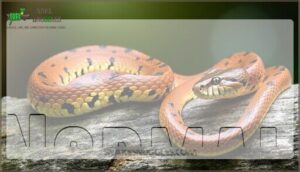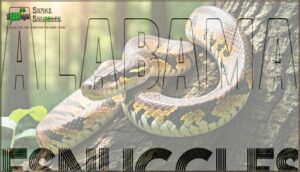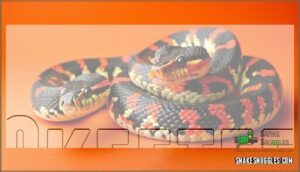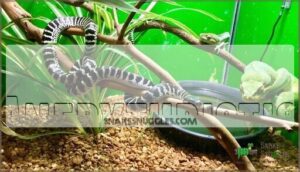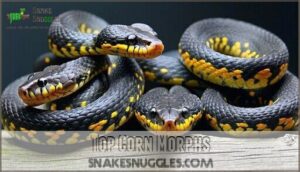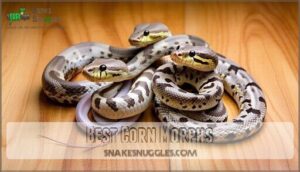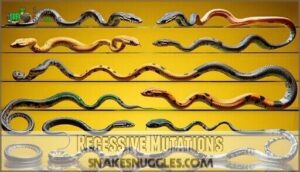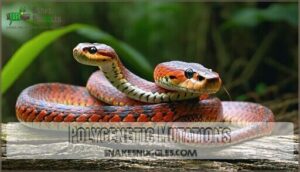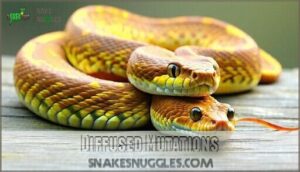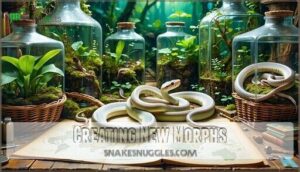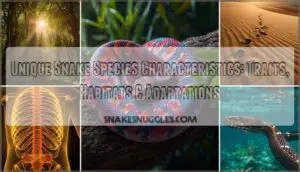This site is supported by our readers. We may earn a commission, at no cost to you, if you purchase through links.
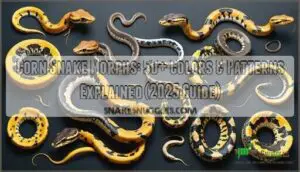
Popular morphs include anerythristics with their gray-silver tones, caramels showing warm browns and golds, and charcoals displaying dramatic grayscale patterns. Pattern variations range from typical blotched designs to motley stripes and banded rings encircling the body.
Genetics play a big role here. Some morphs work as simple recessives—you need both parents carrying the gene to get the trait. Others involve more complex inheritance where multiple genes interact.
Once you understand how these genetics work, you can start planning your own unique combinations.
Table Of Contents
- Key Takeaways
- Corn Snake Morphs
- Main Pattern Types
- Corn Snake Genetics
- Popular Corn Morphs
- Top Corn Morphs
- Best Corn Morphs
- Recessive Mutations
- Polygenetic Mutations
- Diffused Mutations
- Creating New Morphs
- Frequently Asked Questions (FAQs)
- What is the most popular corn snake morph?
- What is an amel corn snake?
- What is a sunkissed corn snake?
- What makes a moonstone corn snake?
- How much do different corn snake morphs cost?
- What are the rarest corn snake morphs available?
- How do corn snake morphs impact their temperament?
- Can corn snake morphs be bred with other species?
- How much space does a corn snake need?
- What temperatures are best for corn snakes?
- Conclusion
Key Takeaways
- You’ll find corn snake morphs are genetic variations created through selective breeding, ranging from basic normals at $30-$70 to rare combinations like Palmetto females costing $550+
- Understanding genetics helps you predict breeding outcomes – recessive traits like amelanistic need both parents carrying the gene, while dominant traits like tessera show up with just one copy
- Popular foundation morphs include amelanistic (lacking black pigment), anerythristic (lacking red/yellow), charcoal (grayscale), and caramel (warm browns/golds) that you can combine to create designer variations
- You can create new morphs by crossing different genetic traits, but success requires detailed record-keeping and understanding inheritance patterns across multiple generations
Corn Snake Morphs
Anyone entering the realm of corn snake morphs discovers a fascinating landscape of color genetics and pattern variations. These genetic mutations have transformed simple wild-type snakes into hundreds of stunning designer varieties through decades of selective snake breeding.
When you start looking at different morphs, you’ll see how genetics controls everything from those striking white amelanistics to deep charcoal grays.
Every morph tells a story about how specific genes work together in breeding.
Common varieties have their appeal, but the real excitement comes with rare corn snake morphs.
Getting familiar with basic pattern variations opens up a world of breeding possibilities you never imagined. The genetic diversity really is endless – each breeding project feels like unwrapping a surprise.
Main Pattern Types
When you’re selecting corn snakes, you’ll encounter five primary pattern types that define how their markings appear across their bodies.
Breeders take these basic patterns—typical blotched, motley, banded, zipper, and plain—and mix them with different color mutations to develop hundreds of striking morphs.
Typical Blotched
Most corn snake morphs showcase blotched patterns as their foundation—those distinctive saddle-shaped markings that define classic corn snake genetics. You’ll recognize these rounded blotches running down the snake’s back, creating perfect contrast against base colors.
The genetics behind corn snakes determine these color shifts—think bright oranges flowing into rich browns.
Getting familiar with blotched patterns makes it easier to identify different morphs and plan your breeding projects.
Motley
Beyond the typical blotched pattern lies the intriguing motley pattern, where Snake Genetics create stunning transformations. This simple recessive mutation breaks traditional saddles into distinctive stripes and dashes, revolutionizing Pattern Inheritance through Morph Breeding programs.
Key Motley Patterns include:
- Lavender Motley – combines purple hues with broken striping
- Ghost Motley – features muted colors with subtle pattern variations
- Strawberry Motley – displays intense reds in fragmented designs
Color Variations like Scaleless Anery Motley showcase how this gene transforms any base morph into something remarkable.
Banded
Striking crossbands that wrap completely around your snake’s body define the banded corn snake morph. These distinctive patterns result from specific breeding techniques that amplify naturally occurring color variations.
- Complete bands encircle the entire body circumference
- Amplified color contrast between bands and background
- Genetic inheritance follows predictable breeding patterns
Banded patterns showcase remarkable diversity in corn snake morphs, creating some of the most visually stunning genetic combinations available.
Zipper
You’ll encounter Zipper Patterns in corn snakes displaying distinctive dorsal striping that resembles a zipper’s teeth. These Scale Mutations create interrupted Stripe formations different from standard Motley patterns. Snake Genetics behind zipper morphs involve complex interactions between multiple genes affecting pigment distribution and scale development.
| Pattern Feature | Zipper Trait | Breeding Result |
|---|---|---|
| Dorsal stripe | Interrupted segments | Heterozygous offspring |
| Side patterns | Reduced blotching | Variable expression |
| Belly scales | Modified checkers | Genetic complexity |
| Color intensity | Enhanced contrast | Breeding Techniques vary |
Zipper Corn Snakes showcase how Color Morphs can create stunning visual effects through selective breeding programs targeting specific pattern mutations.
Plain
Unlike patterned varieties, plain corn snakes showcase solid colors and patternless snakes in their purest form. These simple morphs highlight base tones and earthy hues without traditional markings:
- Terrazzo: Light gray patternless snakes with subtle speckles
- Sunglow: Bright yellow corn snake color variations resembling sunshine
- Fluorescent amelanistic: Vivid orange morphs glowing under UV light
Plain varieties prove that corn snakes don’t need complex patterns to captivate—sometimes less truly is more.
Corn Snake Genetics
Corn snake genetics lets you figure out what baby morphs you’ll get when you pair different colors and patterns. You’re dealing with dominant genes that pop up right in the first generation, plus recessive ones that need both parents carrying the same trait to actually show up.
Some genes are dominant and show up right away in the babies, while others are recessive and only appear when both parents carry that same hidden trait.
Dominant Genes
Dominant genes in corn snakes express their genetic traits when you inherit just one copy from either parent. Tessera, the most common dominant trait, creates distinctive striped patterns with 50% inheritance rates. Gene interaction between dominant alleles produces stunning combinations like striped bloodred morphs.
| Dominant Trait | Visual Impact |
|---|---|
| Tessera | Unbroken dorsal stripe |
| Palmetto | Scattered white patches |
| Scaleless | Amplified colors/patterns |
Understanding the molecular biology behind genetic expression helps predict breeding corn snake outcomes effectively. Studying snake genetic traits is essential for breeders to create unique morphs.
Recessive Genes
Recessive genes require both parents to carry the mutation for gene expression to occur. Amelanistic and anerythristic morphs showcase classic recessive traits – you won’t see the morph unless both alleles match.
Genetic inheritance follows predictable patterns, with mutation rates creating stunning color variations. These genetic traits in snakes produce the most dramatic transformations, turning ordinary corns into remarkable specimens.
Heterozygous Offspring
When breeding heterozygous corn snakes, you’re working with genetic inheritance that creates fascinating possibilities. Each parent contributes one gene copy, and breeding strategies using Punnett Square Calculator show 50% heterozygous offspring in typical crosses.
These carriers display hybrid vigor while hiding recessive genetic traits. Gene expression varies with incomplete dominance, making genetic mutations and color unpredictable yet exciting for genetics and heredity enthusiasts.
Popular Corn Morphs
These five core morphs show up in pretty much every breeding setup—they’re what breeders use to create all those wild combinations.
Normal, Alabama, Okeetee, Caramel, and Anerythristic morphs are your safest bets when you’re just getting into collecting or want to start breeding.
Normal
What makes normal corn snake morphs so special among corn snake color morphs? These wildtype corn snakes represent the foundation of pattern genetics, displaying the classic appearance that captivates beginners and experts alike.
Normal colors showcase the species’ authentic beauty, making these red variants essential breeding stock. At $40-70, they’re perfect starter snakes that demonstrate why corn snakes remain America’s favorite. The unique characteristics of corn snakes, including their calm nature and attractive appearance, make them a popular choice for those interested in reptile pet care.
- Orange-red base colors with vibrant saddle markings
- Black-bordered blotches creating stunning contrast
- Natural wild-type genetics serving as base morphs
Alabama
Alabama corn snakes showcase stunning Wild Encounters from Southeastern Ecology, displaying copper-brown blotches against cream backgrounds.
These Regional Breeding favorites from Alabama Habitats offer beginner-friendly Reptile Husbandry requirements.
Snake Conservation efforts protect wild populations, while Pet Snakes bred in captivity maintain genetic diversity.
You’ll find Alabama morphs priced reasonably, making them accessible entry points into Corn Snake Morphs collecting without sacrificing visual appeal.
Okeetee
Okeetee corn snakes command attention with their vibrant red dorsal blotches outlined by thick black borders against orange backgrounds. These Florida natives showcase remarkable morph classification through selective snake breeding programs targeting intense color patterns.
Their striking appearance makes them highly sought-after morphs among collectors.
- Wild Okefenokee genetics produce naturally bold pigmentation
- Reverse Okeetee variants display inverted color schemes
- Breeding pairs require careful anerythristic gene considerations
- Okeetee care demands proper heating for ideal coloration
Caramel
Caramel morphs showcase neutral brown, gold, and yellow tones that develop deeper richness as snakes mature. This caramel genetics mutation affects how color patterns express themselves, creating stunning morph variations that rival strawberry and candy cane corn snakes.
Snake breeding programs often pair caramels with other morphs to produce unique combinations. Their earthy palette makes excellent pet care choices for enthusiasts seeking warm, natural-looking morphs.
Anerythristic
When you compare Anerythristic genetics with other Corn Snake Morphs like Amelanistic, the Anerythristic mutation blocks red and yellow pigment production. These beauties lack red pigment, producing silvery-blue tones and a gray-white appearance.
Snake Breeding programs targeting Color Variation often use Anery Stripe Okeetee and Scaleless Anery Okeetee combinations. Morph Classification requires careful Genetic Research to identify true Anerythristic traits.
Top Corn Morphs
You’ll encounter the most sought-after corn snake morphs when you focus on these five genetic powerhouses that consistently produce stunning visual results.
These top-tier mutations—Charcoal, Amelanistic, Hypomelanistic, Cinder, and Diffused—represent the foundation genes that experienced breeders use to create complex combination morphs worth hundreds of dollars.
Charcoal
When charcoal genetics take hold, you’ll witness nature’s monochrome masterpiece. This recessive morph strips away yellow pigments, creating stunning grayscale corn snakes with dark scales and black traits.
- Eliminates red and yellow pigments completely
- Displays silver-gray base coloration
- Features charcoal-black saddle patterns
- Creates striking anerythristic appearance
Sunkissed charcoal combinations push these color morphs even further, proving snake patterns can be beautifully minimalist.
Amelanistic
Unlike charcoal morphs, amelanistic corn snakes showcase vibrant beauty through melanin deficiency. These albino variants lack dark pigments entirely, revealing stunning whites, yellows, and oranges.
Amelanistic genetics create recessive mutations requiring both parents to carry the gene.
Popular albino morphs include bloodred amelanistics with deep crimson tones and butter amelanistics displaying creamy yellow hues throughout their snake coloration.
Hypomelanistic
Hypomelanistic corn snakes showcase reduced melanin production, creating lighter versions of natural colors without complete pigment loss like albino morphs. This genetic variation produces stunning visual effects through controlled melanin reduction.
- Snake coloration appears softer with muted browns and grays
- Pattern inheritance maintains distinct markings with reduced contrast
- Genetic variation differs from anerythristic morphs through partial melanin suppression
Hypomelanistic genetics create these beautiful morphs through selective breeding programs targeting specific pigmentation genes.
Cinder
Cinder corn snakes showcase striking genetics that remove warm colors completely. Cinder removes red, orange, and yellow colors and leaves a brick red patterning on a gray base. The unique "dovetail" pattern along their spine makes these color morphs unmistakable.
This recessive mutation requires both parents to carry cinder genetics for morph breeding success. Their muted palette creates an entirely different snake behavior pattern that appeals to collectors seeking unusual pet care specimens.
Diffused
When breeding corn snakes, the diffused morph creates mesmerizing color shift patterns where traditional boundaries dissolve completely. This recessive gene expression transforms standard corn snake morphs into living watercolors, blending hues seamlessly across their scales.
Here’s what makes diffused patterns special in snake breeding:
- Faded saddle borders that melt into the background coloration
- Gradient transitions replacing sharp pattern edges
- Enhanced color saturation throughout the entire body
- Reduced contrast creating ethereal, dream-like appearances
Morph genetics behind diffused corn snakes involve simple recessive inheritance, making breeding programs predictable for experienced keepers.
Best Corn Morphs
You’ll find these five morphs represent the summit of corn snake breeding achievements, combining striking visual appeal with proven genetic stability.
Each morph showcases decades of selective breeding work, from the clean longitudinal lines of Striped specimens to the ethereal white beauty of Blizzard combinations.
Striped
Striped corn snakes showcase a "railroad track" appearance down the spine, with distinct color patterns controlled by CLCN2 gene mutations. This pattern inheritance creates clean striped patterns instead of traditional blotches.
Color genetics make each stripe unique, transforming your collection through snake breeding.
The morph classification sets them apart from motley and diffused variants, even when combined with scaleless traits for stunning results.
Topaz Motley
When you’re searching for golden elegance, the Topaz Motley delivers stunning amber hues paired with the signature broken pattern.
Snake genetics combine the recessive motley gene with selective breeding techniques to produce these enchanting color morphs.
Topaz variations showcase how careful color morphing transforms ordinary corn snakes into remarkable specimens with distinctive motley patterns.
Sunkissed Ultramel
Many breeders consider the Sunkissed Ultramel a landmark in corn snake morphs, combining Sunkissed genetics with amelanistic traits. This creates stunning ultramel patterns featuring warm golden-yellow bases with reduced melanin.
The color inheritance produces snakes lacking dark pigments while maintaining vibrant amber tones. These corn snakes showcase remarkable snake morphology, making them highly sought after in breeding techniques for creating designer charcoal-free variations.
Buck Skin Okeetee
Buck Skin Okeetee morphs showcase striking genetics combining hypomelanistic traits with classic Okeetee patterns. You’ll notice the reduced black borders let those burnt orange saddles really pop against desert tan backgrounds.
This breeding combination produces outstanding-looking animals with vibrant orange and red coloration. Snake husbandry remains straightforward, while the Buck Skin genetics offer endless breeding possibilities for creating stunning designer corn snakes and morphs.
Blizzard
Winter genetics create some extraordinary Snow Morphs in corn snakes. Blizzard corn snakes combine charcoal and albino genes, resulting in stunning white bodies with ruby-red eyes.
These Frost Colors develop from removing both black and red pigments. Their Ice Patterns appear completely patternless, creating Cold Adaptation beauty.
Breeders value these Winter Genetics morphs for their striking contrast.
Recessive Mutations
Recessive mutations need both parents carrying the same gene before you’ll see visual offspring pop up in your breeding program.
Amelanistic and anerythristic genes work like clockwork when it comes to inheritance. Since they’re single-gene traits, breeders love using them as stepping stones to build wild-looking complex morphs.
Amelanistic (Amel)
Amelanistic corn snakes showcase one of morph breeding’s most celebrated achievements. The OCA2 gene carries a genetic insertion that blocks melanin production , creating stunning albino-like morphs with vibrant colors.
- Complete melanin loss produces striking white and orange patterns
- Pink eyes distinguish true amelanistic from other albinism types
- Amel genetics enable countless combination morphs in snake coloration
These corn snakes demonstrate how single-gene mutations transform basic patterns into designer creations that captivate reptile enthusiasts worldwide.
Anerythristic (Anery)
While Amelanistic corn snakes dazzle with their vibrant reds and oranges, Anerythristic morphs take the opposite approach. These striking snakes lack red pigmentation entirely, creating dramatic grayscale patterns. You’ll notice their pale silver-gray base colors contrasted by bold charcoal blotches.
Anery Care remains straightforward, and Snake Genetics behind this recessive trait produces consistent Color Variations. Understanding Anery Breeding helps predict offspring outcomes when crossing morphs in your breeding program.
Polygenetic Mutations
Unlike simple recessive mutations, polygenetic mutations involve multiple genes working together to create specific traits. The bloodred morph perfectly demonstrates this complex genetic inheritance pattern, where gene expression from several loci must align perfectly.
Polygenic traits work differently than simple one-gene mutations. They’re messier and more complex:
- Genetic variation through multiple gene combinations
- Variable mutation rates across different breeding lines
- Complex trait inheritance patterns that challenge traditional morph classification
You’ll notice bloodreds appearing unpredictably in wild populations when genetic mutations randomly combine correctly. However, experienced breeders can reliably produce these stunning morphs by understanding which genetic diversity markers indicate the necessary allele combinations. This mutation type represents breeding artistry at its finest, transforming random genetic inheritance into predictable results through careful selection.
Diffused Mutations
Beyond polygenetic mutations, diffused mutations create some of the most striking visual effects in corn snakes. These genetic mutations cause Pattern Diffusion where distinct markings blur into surrounding colors, creating watercolor-like appearances. Gene Expression varies markedly between individuals, making each snake unique. Genetic Drift influences how these traits manifest over generations, while Mutation Rates determine their frequency in breeding populations.
Diffused morphs showcase nature’s artistry through subtle Color Shift patterns:
- Amelanistic diffused snakes display soft yellows and oranges without harsh borders
- Pattern edges fade gradually rather than maintaining sharp definition
- Color intensity varies across the body, creating gradient effects
- Genetic Mutations produce unpredictable but beautiful combinations
- Each individual expresses diffused traits differently, ensuring no two look alike
These Corn Snakes represent living masterpieces where genetics meets art.
Creating New Morphs
Creating new morphs happens when you cross different genetic traits through selective breeding programs. You’re hunting for specific combinations of recessive and dominant alleles.
Your breeding success comes down to understanding inheritance patterns and keeping detailed records. Track genetic outcomes across multiple generations to see what works.
Breeding Programs
Successful breeding programs start with careful snake pairing based on genetic testing and heredity analysis. You’ll need breeding strategies that consider morph selection alongside proper husbandry requirements.
Breeding corn snakes requires understanding reptile genetics and genetic inheritance patterns. Most programs maintain detailed records tracking lineage through multiple generations, safeguarding genetic diversity while developing new morphs systematically.
Homozygous Recessive
Mastering homozygous recessive breeding unlocks predictable morph creation. You’ll need parent snakes carrying identical recessive alleles to produce stable offspring with expressed traits like amelanistic or anerythristic patterns.
Essential homozygous recessive considerations:
- Genetic inheritance requires both parents carrying recessive traits for gene expression
- Mutation rates remain consistent when breeding homozygous amelanistic or hypomelanistic morphs
- Inbreeding effects can reduce fertility, so maintain genetic diversity in your breeding stock
- Albino morphs result from homozygous recessive mutations affecting melanin production completely
Crossing Morphs
Crossing morphs unlocks unlimited breeding possibilities by combining different genetic traits. Your Breeding Programs use Genetic Calculator tools to predict Morph Combinations and Gene Expression patterns. When you pair different morphs, Color Variations emerge through Pattern Inheritance—creating entirely new corn snake morphs:
- Vibrant double-recessive combinations like ghost corns (anery + amel)
- Stunning triple-trait morphs displaying multiple genetic markers
- Hybrid Breeding projects producing novel pattern variations
- Designer creations showcasing enhanced Morph Classification potential
Frequently Asked Questions (FAQs)
What is the most popular corn snake morph?
While many think "most popular" means flashy designer breeds, you’ll find the Normal or Wild-type remains the top choice.
Its classic orange base with red blotches outlined in black stays affordable and beautiful.
What is an amel corn snake?
An amel corn snake is short for "amelanistic," meaning it can’t produce melanin (black pigment).
You’ll see beautiful reds, oranges, yellows, and whites instead of darker colors in these popular morphs.
What is a sunkissed corn snake?
Picture sunlight hitting amber glass – that’s your sunkissed snake. This recessive mutation, founded by Kathy Love, reduces melanin and changes pattern, creating warmer oranges with reduced black borders throughout their beautiful design.
What makes a moonstone corn snake?
A moonstone‘s the result of crossing amelanistic (lacking black pigment) with lavender genetics. You’ll get this stunning pale, silvery snake with ghostly patterns and reduced contrast throughout its body.
How much do different corn snake morphs cost?
Common morphs like normals and albinos usually cost $30-70, while rare combinations like High Pied Okeetee reach $200-300, and premium female Palmetto morphs can exceed $
What are the rarest corn snake morphs available?
You’ll find the rarest morphs like Scaleless at $500, Palmetto females at $550+, and Terrazzo commanding premium prices. Limited genetics make these mutations scarce treasures.
How do corn snake morphs impact their temperament?
Corn snake morphs don’t affect temperament at all. You’ll find that genetics controlling color and pattern are completely separate from behavioral traits, so your snake’s personality stays consistent regardless of morph.
Can corn snake morphs be bred with other species?
Yes, you can breed them with closely related species like Great Plains rat snakes, kingsnakes, and milk snakes. However, these hybrids often face fertility issues and aren’t accepted by purists.
How much space does a corn snake need?
Adults need at least a 40-gallon tank, though 48″L x 24″W x 24″H is better since corn snakes are enthusiastic climbers. Young snakes start fine in 10-gallon setups.
What temperatures are best for corn snakes?
You’ll want to maintain temperatures between 75-82°F on the cool side and 80-85°F on the warm side, with a 88-92°F basking area.
This thermal gradient lets your snake thermoregulate properly.
Conclusion
Apparently, Mother Nature wasn’t satisfied with just one perfect corn snake design—she’d to show off with over fifty variations. Whether you’re starting with basic corn snake morphs like normals and amelanistics or diving into complex polygenic combinations, understanding genetics opens endless breeding possibilities.
Mother Nature apparently wasn’t satisfied with just one perfect corn snake design, so she created over fifty stunning genetic variations
From striking charcoals to vibrant caramels, each morph tells a story of careful selection and genetic patience. Your snake collection’s only limit is your imagination—and perhaps your spouse’s tolerance for "just one more" terrarium.


